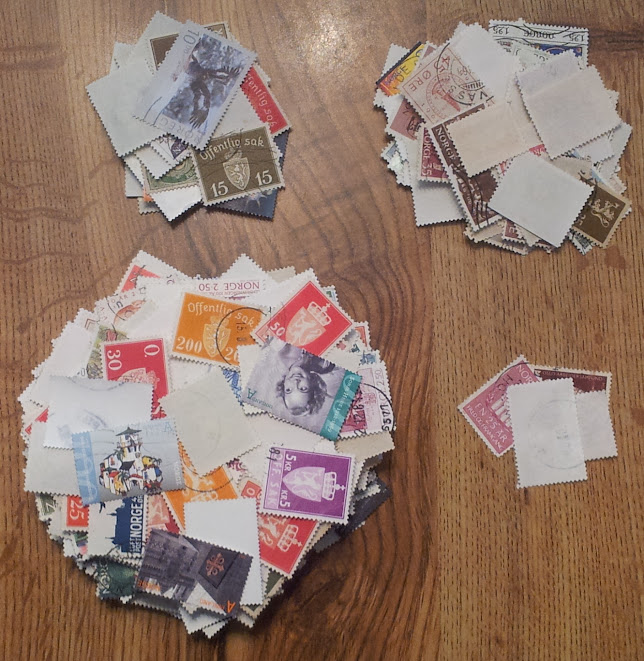At the moment, much of my time working on stamps is spent on sorting big mixtures of stamps. I like buying bulk lots – there is almost always something new for my collection, and I also get lots of doubles that build up my trading stock. I’m especially happy when I can find single-country lots from places that don’t show up too often in worldwide mixes. Let’s look at one mixture that I have just finished sorting, roughly 100 grams of mostly used stamps from Lebanon.
Lebanese stamps aren’t too difficult to find, but if I were to buy a pound of mixed worldwide stamps, I wouldn’t be too shocked if it didn’t contain any stamps at all from Lebanon. Maybe it would contain 3 or 4 Lebanese stamps, which would be kind of normal. Maybe I would get real lucky and there would be 25 stamps from Lebanon. On very rare occasions, I’ll find larger mixes strictly from Lebanon, and that was the case recently. I found a Danish eBay seller with many mixes from countries that I seldom see in bulk – among others, I also picked up mixes from Iraq, Syria, Jordan (all of these primarily postally used stamps), various Congos (a mix of mint, CTO and postally used), Guinea-Bissau, São Tomé & Príncipe, Guinea (primarily cancelled-to-order stamps), even a mix of CTO stamps from Benin, a country I very rarely come across. Nothing horribly exciting for classic stamp collectors, I’m sure they wouldn’t be too interested in CTO stamps, but I always say I’m happy to collect anything for which I have a catalogue. It’s even better if I can get a bunch of stamps to trade as well.
Here’s a photo showing my sorting in progress shortly after I got started. I like my used stamps to be clean, with no hinge remnants, no gum left behind, no warps and wobbles, etc. A very large percentage of off-paper stamps will get soaked again to make them as clean as I like them, but I’ll usually also find some that have been soaked cleanly already, so they can go straight into the country pile that will be ready for sorting, cataloguing and counting.

Sorting my mixture of Lebanese stamps.
The stamps in the bottom two piles are “ready to go” – the bottom left pile contains clean off-paper stamps and the bottom right pile contains gummed stamps. For Lebanon, these gummed stamps are primarily mint stamps, although I do have a few that are CTO. The other stamps in the top piles have gum, hinges or paper remnants that I want to remove, so they will need to be soaked. These stamps get sorted according to how soon I want to soak them. Damaged stamps and boring old things that are already in my collection by the hundreds don’t need to get soaked until I have absolutely nothing left to soak, so those stamps might have to wait a long, long time before they get their bath (upper left pile – in this case, I obviously don’t have a massive surplus of any Lebanese stamps so these are all damaged stamps). Stamps that aren’t damaged are put into three different piles depending mostly on how happy I am to get more of them – in this case, all of Lebanon’s stamps go in the “better” box. These stamps are in the upper right pile, a fairly large group because most of the stamps in this mixture have been hinged before. And the single stamp in middle? That’s a mistake, a stamp from Libya instead of Lebanon, and used Libyan stamps go in the “oh boy, soak it as soon as I can” pile because I rarely ever get any Libyan stamps. I’m always happy to get more and I want to get them sorted into my collection as soon as I can.
You can see that the pile of damaged stamps that need to be soaked is very small in comparison to the pile of undamaged stamps that need soaking. I’m very pleased with this mix, it’s unusual to receive such a high percentage of undamaged stamps in a random mix like this.

A baking tin containing clean stamps from Lebanon.
I’ve finished sorting through the 100 gram bag and the clean stamps have been added to their country pile. In this case, I have enough Lebanon stamps that they go into a baking tin, which is stacked with other tins. Once upon a time about 5 years ago, I bought a stock of various Lebanon stamps so I have a fair-sized pile of them now. When the other pile of Lebanon stamps receive their soaking, that pile will grow considerably.
The gummed stamps go into a shoe box – in this case the box contains glassine envelopes belonging to the countries which have their own baking tins. Once I get enough stamps in a glassine (in excess of 32 grams), I put them into 102A index cards, 20 per card, and they go into long red boxes. This way, the gummed stamps are never stacked, which can cause impressions (dents!) into the gum from neighbouring stamps. By the time I was finished sorting this mix, my glassine of gummed stamps was full and I had to put the stamps into the red boxes. I’ll show my various tins and boxes in a future post.

Gummed stamps go into glassine envelopes in shoe boxes.
By the time I had finished working through my initial sort of this mixture of stamps from Lebanon, my stamps ready for cataloguing totalled just over 150 grams. That’s probably around 1800 stamps or so. That means there will be quite a few Lebanese stamps in my stock of trading stamps. If your collection is weak in stamps from Lebanon, I might have some stamps you’ll be interested in!
















